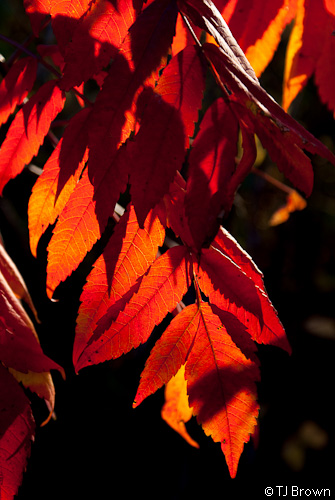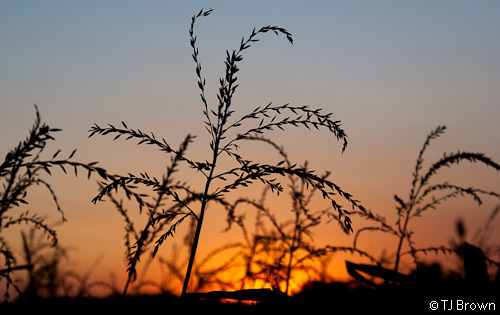
Natural lighting
Many cameras will automatically fire the flash in low light, but sometimes natural lighting can produce a superior effect. Next time you are out with your camera, consider turning off the flash and looking for ways to take advantage of available light. This is one area where you simply have to be creative and try different things until you are happy with the result. In the photo on the right, I waited until the setting sun lit up the sumac leaves from behind.
Exposure
In photography, exposure refers to the light hitting the film or sensor to produce an image. There are three principal components of exposure: shutter speed, aperture, and ISO. While cameras today can manage these elements for you and produce acceptable results most of the time, if you want to take full control over your photographs you will need to understand how these components work together.
Shutter speed is the length of time that light is allowed to strike the film or sensor. Most cameras today are capable of shutter speeds between 30 seconds and 1/4000th sec. Fast shutter speeds can be used to freeze movement, and long exposures can be used to blur the subject and convey a sense of motion.
The aperture is an adjustable opening which allows light to pass through the lens to the camera sensor. The larger the aperture, the more light will be allowed to reach the sensor, and the less time the shutter will need to be open to correctly expose the image. Smaller apertures allow less light to strike the sensor, but they give the image an increased depth of field (a greater range of elements will be in focus). Small apertures are denoted by large f-numbers (such as f/22), and large apertures are denoted by small f-numbers (such as f/2.8).
ISO refers to the sensitivity of the film or sensor. Higher ISOs are more sensitive, and lower ISOs are less sensitive. For example, an image taken at ISO 400 will require half the shutter speed of an image taken at ISO 200 to receive the same exposure. The downside to higher ISOs is that they can cause images to become more susceptible to noise or graininess.

Silhouettes
Silhouettes are created when the image is exposed for a light source that is behind the subject. This technique is useful when you want to emphasize a subject's position or shape, rather than its details.
Next: Learn about composition.